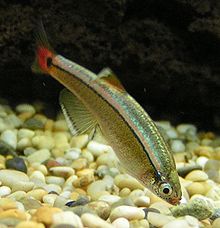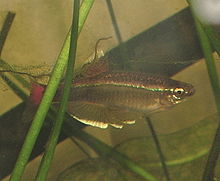- White Cloud Mountain minnow
-
White Cloud Mountain Minnow 
Scientific classification Kingdom: Animalia Phylum: Chordata Class: Actinopterygii Order: Cypriniformes Family: Cyprinidae Genus: Tanichthys Species: T. albonubes Binomial name Tanichthys albonubes
S. Y. Lin, 1932The White Cloud Mountain minnow(Tanichthys albonubes) is a hardy, species of freshwater fish and coldwater fish often kept in aquaria.These creatures are brilliant for children as very easy to look after. It is a member of the carp family (family Cyprinidae) of order Cypriniformes,[1] native to China. The White Cloud Mountain Minnow is practically extinct in its native habitat. It was believed to be extinct for some years, but an apparently native population of this fish was discovered on "Hainan Island", well away from the White Cloud Mountain. They are bred in farms and are easily available through the aquarium trade.[2]
The species was discovered at White Cloud Mountain (白雲山; Pinyin Bái Yún Shān) in Guǎngdōng in the 1930s by a Boy Scout leader called Tan, a distant relative of Tan Meng Yoe —hence the generic name Tanichthys ("Tan's fish"). The specific name albonubes is from the Latin alba nubes (white cloud).
The fish are sold in the aquarium trade under a variety of names, including White Cloud, White Cloud Mountain fish, White Cloud minnow, etc. The names Canton or China danio (although it is not technically a danio) and cardinal fish are also encountered. In Chinese the fish is known as 唐魚 (táng yu), 廣東細鯽 (Guǎngdōng xìjì), or 潘氏細鯽 (pānshì xìjì). Aphyocypris pooni is an obsolete synonym for this species; it was coined to designate a color variety which is now known to be the same species as the White Cloud Mountain minnow.
Contents
Description
This species grows to approximately 4 cm (roughly 1.5 in) in overall length, and is silver-green in color with a bright red caudal fin. Several varieties are known, one with bright light edges to the dorsal and anal fins and one with red edges to those fins.[3] In addition, there is a long-finned variety and a golden variety. Sexual dimorphism is slight. The male generally has brighter colors and a slimmer body.
In the aquarium
White Cloud Mountain minnows are considered good fish for beginners, as they are extremely forgiving with regard to aquarium temperature and water quality. They are often sold as ideal "starter fish" for cycling a new aquarium, however it is kinder if they are introduced to an already cycled tank. They are schooling fish, and feel most comfortable in a group of at least five. An individual of these minnows kept alone may become timid and lose its bright color. White Clouds are generally peaceful and happy to coexist with other fish, as long as they are not put in a tank with larger fish that may eat them. The minnows are usually top or middle-level swimmers and rarely swim close to the bottom of a tank.
Although the nominal temperature range for the species in the wild is 18–26 °C (64–79 °F), it can survive water temperatures down to 5°C (41°F).[4] This makes it an ideal fish for keeping in an unheated aquarium in cold climates. In fact, White Clouds are more active and healthier when kept at temperatures lower than those at which most tropical tanks are kept. Water hardness (dH) should be from 5 to 19, and pH levels should range between 6.0 and 8.0. Also, the aquarium should have a top. White Clouds have been known to jump out on rare occasions.
During the 1940s and 1950s, White Cloud Mountain minnows acquired the nickname, the "Poor Man's Neon Tetra," because they were much more affordable in price than the colorful and then expensive Neon Tetras.[5]
Two variants are commonly available: the "Golden Cloud" and the longer-finned "Meteor Minnow." The Golden Cloud is a relatively new variety as compared to the Meteor Minnow. The Meteor Minnow first made its appearance in the 1950s in Perth, Western Australia and the Golden Cloud in the 1990s. Breeding between the two varieties has recently resulted in another attractive fish, the "Golden Meteor Minnow." Inbreeding of Golden Clouds have resulted in "Blonde" Clouds, light yellow specimens similar in colour to blonde guppies and "Pink Clouds", flesh colour specimens which lacks further pigmentation still.
In the pond
Although it is a small fish, the White Cloud Mountain Minnow is sometimes used as a pond fish, especially in ponds intended for frogs to breed. The White Cloud Mountain Minnows do not eat either the frog eggs, or the tadpoles, but will control the breeding of mosquitoes. They will breed readily in ponds as long as there are no other fish. While they can endure temperatures as low as 5°C (41°F), they should have good heating systems in the pond to prevent the water from freezing over in climates where this occurs regularly, making them more ideal for Subtropical climates (similar to their native habitat).
Breeding
White Clouds are easy to breed and are recommended for novice breeders. They may be conditioned for breeding with live foods such as brine shrimp and daphnia. The most colorful minnows should be placed in a small tank with a spawning mop or some java moss. Males will attempt to attract females by displaying their fins, often alongside one another. White Clouds are egg-scatterers, dropping their eggs freely amongst the vegetation. Because they do not generally cannibalize their offspring, the parents can be left in the tank.
White cloud eggs hatch within 48 to 60 hours. The tiny fry may be visible on the sides of the glass or among plants. After they are free swimming, they can be fed a finely powdered fish food or infusoria.[5]
See also
References
- ^ "Tanichthys albonubes". Integrated Taxonomic Information System. http://www.itis.gov/servlet/SingleRpt/SingleRpt?search_topic=TSN&search_value=163764. Retrieved 7 December 2004.
- ^ "New population of endangered White clouds discovered". Practical Fishkeeping. http://www.practicalfishkeeping.co.uk/content.php?sid=2022. Retrieved 2009-07-29.
- ^ Dawes, John (2001). Complete Encyclopedia of the Freshwater Aquarium. New York: Firefly Books Ltd. ISBN 1-55297-544-4.
- ^ Froese, Rainer, and Daniel Pauly, eds. (2004). Tanichthys albonubes in FishBase. October 2004 version.
- ^ a b Rundle, J. (March, 2004). How to Breed White Clouds. Practical Fishkeeping
External links
Categories:- Rasborinae
- Fish of China
- Fauna of Hong Kong
Wikimedia Foundation. 2010.



